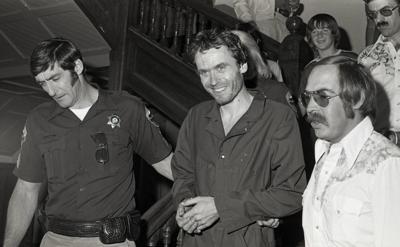In the late 1970s, one of the most prolific serial killers in U.S. history committed a streak of brutal murders across the country, including several in Colorado's ski country. Theodore 'Ted' Bundy arrived in Colorado in 1975 and officials suspect that least three women were killed during his brutal time spent in the state.
Caryn Campbell, a 23-year-old nurse from Michigan, was on vacation with her fiancé in Snowmass Village when she crossed paths with Ted Bundy in January of 1975. Her beaten body was later discovered in a snowbank near town.
Julie Cunningham, 26, was working as a ski instructor in Vail when she went missing in March of 1975, according to the Colorado Bureau of Investigation (CBI).
"Although never charged in her case, serial killer Ted Bundy confessed to Cunningham's murder. Bundy stated that he lured her into his vehicle by posing as an injured skier on crutches and asking her to help carry his ski boot," the official CBI report reads.
Bundy admitted to knocking her unconscious and driving her to a remote location about 80 miles from Vail, where he sexually assaulted and killed her. Her body was never found.
Denise Oliverson is suspected to be the third Ted Bundy victim in Colorado, according to the CBI, though Bundy was never formally charged with her death. Oliverson was riding her bicycle in Grand Junction in April 1975, when she disappeared. Her bike was later found beneath the Fifth Street Bridge. Her body was never located.
"Authorities suspect that Ms. Oliverson was killed by serial killer Ted Bundy. In 1989, days before his execution, Ted Bundy told investigators he had disposed of a body in a river about five miles west of Grand Junction, Colorado. A time-line created by the FBI places Ted Bundy in Grand Junction through April of 1975," the CBI report reads.
Bundy was first arrested in Utah in August 1975, when officers found handcuffs, an ice pick, a crowbar, and several other suspicious items in his car during a traffic stop. In Utah, he was ultimately convicted of attempted kidnapping. From there he was extradited back to Colorado to face a murder charge in the death of Caryn Campbell after a strand of her hair was discovered in his car.
While in custody in Aspen, Bundy opted to defended himself in court, which awarded him access to the law library at the Pitkin's County Courthouse. On June 7, 1977, the killer leapt from a second floor window of the courthouse, while he was unshackled and unguarded.
Bundy was gone for 10 minutes before security guards even noticed he had left, according to a report by ABC news. A full scale man-hunt was launched by the Pitkin County Sheriff's Department, which included searching all vehicles that entered and exited Aspen.
"Residents were warned to lock their doors, and sales of guns and ammunition were ordered halted through Aspen, Glenwood Springs, and other nearby towns," a Rocky Mountain News article from the time said.
In a 1977 interview with the Denver Post, then-Mayor of Aspen Stacey Standley said, "The bars were at least as full as normal and single women were walking around. There isn't a hell of a lot of fear in this town, because everyone lives on the line."
Some residents believed that Bundy would not be able to survive in the "rugged" forest he ran to, the publication said.
Six days after the murderer escaped, he was reportedly pulled over while driving a stolen car. He was then taken to the Garfield County Jail in Glenwood Springs to await trial.
This jail was also unable to keep Bundy in custody for long.
On December 30, 1977, Bundy made his second successful escape from Colorado authorities. He reportedly lost weight intentionally so that he could slip through a small grate in the ceiling of his cell. He then crawled through the airducts to one of the guards' living quarters. From there, he changed clothes and walked to freedom.
From Garfield County, Bundy fled to Tallahassee, Florida, where he carried out several more murders to include the deaths of two college students and a 12 year-old-girl before being caught in February 1978.
Bundy was eventually sentenced to death in three separate trials between 1979 and 1980. The third death sentence would ultimately be the one behind his eventual electrocution.
Of Bundy's murders, Trial Judge Edward Cowart famously said "these killings were indeed heinous, atrocious and cruel. And that they were extremely wicked, shockingly evil, vile and the product of a design to inflict a high degree of pain and utter indifference to human life."
In 1989, Bundy spoke with investigators to confess to his involvement in the slayings that took place over a decade prior, in Colorado and elsewhere around the country.
He was executed via electrocution days later.
In his lifetime, it is believed that Ted Bundy was responsible for at least 30 murders, though some theorists believe that number could be much higher.
STAY INFORMED: Sign-up for the daily OutThere Colorado newsletter here








(0) comments
Welcome to the discussion.
Log In
Keep it Clean. Please avoid obscene, vulgar, lewd, racist or sexually-oriented language.
PLEASE TURN OFF YOUR CAPS LOCK.
Don't Threaten. Threats of harming another person will not be tolerated.
Be Truthful. Don't knowingly lie about anyone or anything.
Be Nice. No racism, sexism or any sort of -ism that is degrading to another person.
Be Proactive. Use the 'Report' link on each comment to let us know of abusive posts.
Share with Us. We'd love to hear eyewitness accounts, the history behind an article.